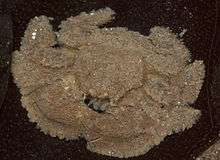Hapalogaster cavicauda
| Hapalogaster cavicauda | |
|---|---|
 | |
| Scientific classification | |
| Kingdom: | Animalia |
| Phylum: | Arthropoda |
| Subphylum: | Crustacea |
| Class: | Malacostraca |
| Order: | Decapoda |
| Family: | Hapalogastridae |
| Genus: | Hapalogaster |
| Species: | H. cavicauda |
| Binomial name | |
| Hapalogaster cavicauda Stimpson, 1859 [1] | |
Hapalogaster cavicauda is a species of king crab that lives on the Pacific coast of North America.
Description
Hapalogaster cavicauda is a flattened, crab-like crustacean. It grows to a carapace width of 20 millimetres (0.79 in),[2] and is covered in setae (hairs). The hairs on the third maxilliped are used to filter plankton from the water, which the animal feeds on, together with algae scraped from rocks.[3] The females carry their eggs on the tail in winter.[3]
Distribution
H. cavicauda is found along the Pacific coast of North America from Cape Mendocino in the north, through the Channel Islands,[4] to Isla San Jerónimo, Mexico in the south.[5] It usually lives beneath rocks in the lower part of the intertidal zone.[2]
The related species H. mertensii occurs further north, but shares a similar ecology to that of H. cavicauda.[3]
Taxonomy
| External identifiers for Hapalogaster cavicauda | |
|---|---|
| Encyclopedia of Life | 342188 |
| ITIS | 97925 |
| Also found in: GBIF | |
The species was first described by William Stimpson in 1859 (as a preprint of an article published in 1862). He based the description on a specimen collected by "Mr. A. S. Taylor" at Monterey, California.[6]
References
- ↑ Patsy A. McLaughlin; Tomoyuki Komai; Rafael Lemaitre; Dwi Listyo Rahayu (2010). Martyn E. Y. Low; S. H. Tan, eds. "Annotated checklist of anomuran decapod crustaceans of the world (exclusive of the Kiwaoidea and families Chirostylidae and Galatheidae of the Galatheoidea)" (PDF). Zootaxa. Suppl. 23: 5–107.
|chapter=ignored (help) - 1 2 Gary McDonald (June 4, 2010). "Hapalogaster cavicauda Stimpson, 1859". Intertidal Invertebrates of the Monterey Bay Area, California. University of California, Santa Cruz. Retrieved January 25, 2011.
- 1 2 3 Edward F. Ricketts, Jack Calvin, David W. Phillips & Joel W. Hedgpeth (1992). "Between Pacific Tides" (5th ed.). Stanford University Press: 17–204. ISBN 978-0-8047-2068-7.
|chapter=ignored (help) - ↑ William K. Emerson (1956). "Upwelling and associated marine life along Pacific Baja California, Mexico". Journal of Paleontology. 30 (2): 393–397. JSTOR 1300275.
- ↑ Sally Hall; Sven Thatje (2009). "Global bottlenecks in the distribution of marine Crustacea: temperature constraints in the family Lithodidae" (PDF). Journal of Biogeography. 36 (11): 2125–2135. doi:10.1111/j.1365-2699.2009.02153.x.
- ↑ William Stimpson (1862). "XI. – Notes on North American Crustacea, No. 1". Annals of the Lyceum of Natural History of New York. 7 (1): 49–93. doi:10.1111/j.1749-6632.1862.tb00142.x.